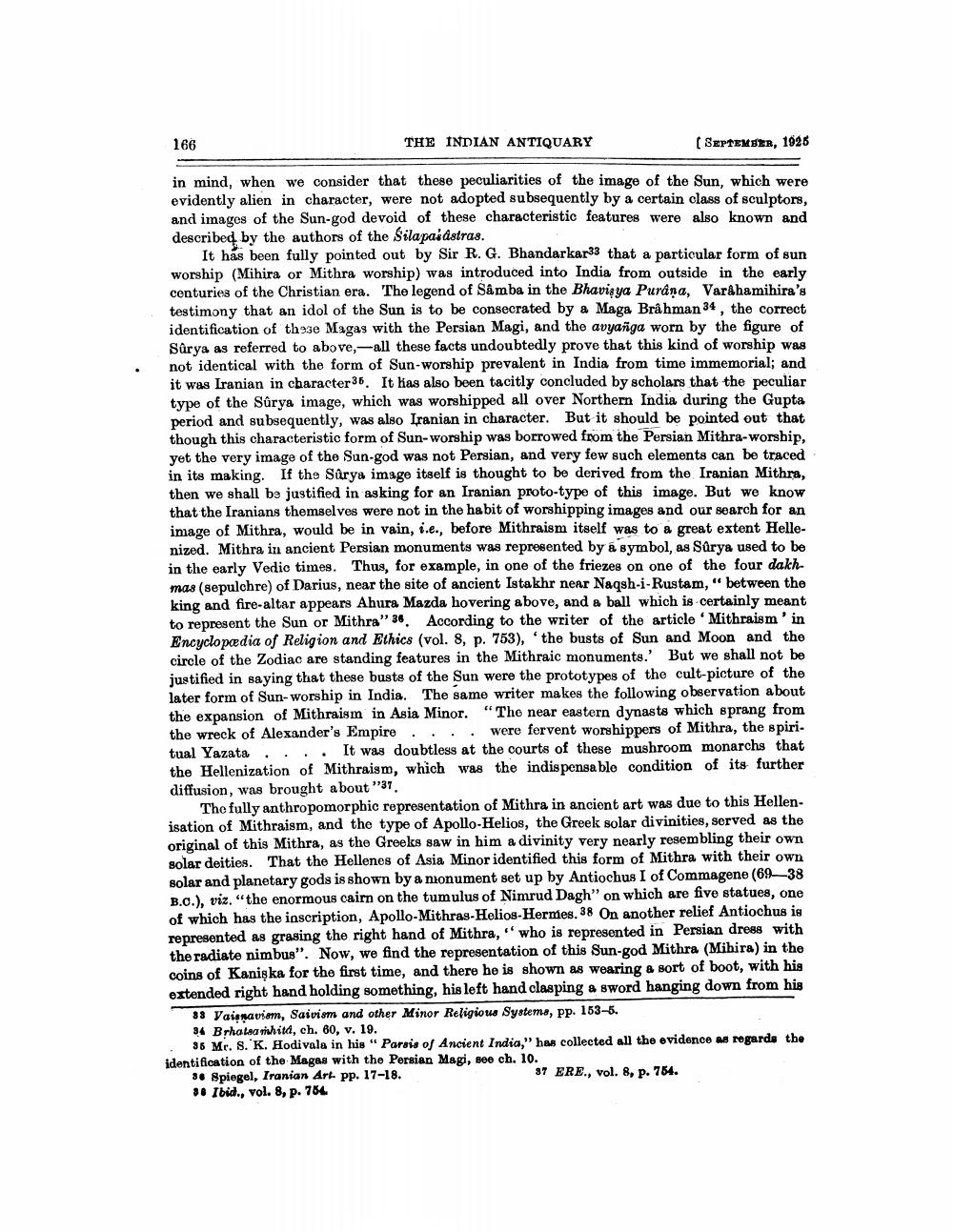________________
166
THE INDIAN ANTIQUARY
in mind, when we consider that these peculiarities of the image of the Sun, which were evidently alien in character, were not adopted subsequently by a certain class of sculptors, and images of the Sun-god devoid of these characteristic features were also known and described by the authors of the Silapaiâstras.
It has been fully pointed out by Sir R. G. Bhandarkar33 that a particular form of sun worship (Mihira or Mithra worship) was introduced into India from outside in the early centuries of the Christian era. The legend of Sâmba in the Bhavisya Purana, Varahamihira's testimony that an idol of the Sun is to be consecrated by a Maga Brahman 34, the correct identification of these Magas with the Persian Magi, and the avyanga worn by the figure of Surya as referred to above,-all these facts undoubtedly prove that this kind of worship was not identical with the form of Sun-worship prevalent in India from time immemorial; and it was Iranian in character 35. It has also been tacitly concluded by scholars that the peculiar type of the Sûrya image, which was worshipped all over Northern India during the Gupta period and subsequently, was also Iranian in character. But it should be pointed out that though this characteristic form of Sun-worship was borrowed from the Persian Mithra-worship, yet the very image of the Sun-god was not Persian, and very few such elements can be traced in its making. If the Sûrya image itself is thought to be derived from the Iranian Mithra, then we shall be justified in asking for an Iranian proto-type of this image. But we know that the Iranians themselves were not in the habit of worshipping images and our search for an image of Mithra, would be in vain, i.e., before Mithraism itself was to a great extent Hellenized. Mithra in ancient Persian monuments was represented by a symbol, as Sûrya used to be in the early Vedic times. Thus, for example, in one of the friezes on one of the four dakhmas (sepulchre) of Darius, near the site of ancient Istakhr near Naqsh-i-Rustam, "between the king and fire-altar appears Ahura Mazda hovering above, and a ball which is certainly meant to represent the Sun or Mithra" 36. According to the writer of the article Mithraism' in Encyclopædia of Religion and Ethics (vol. 8, p. 753), 'the busts of Sun and Moon and the circle of the Zodiac are standing features in the Mithraic monuments.' But we shall not be justified in saying that these busts of the Sun were the prototypes of the cult-picture of the later form of Sun- worship in India. The same writer makes the following observation about the expansion of Mithraism in Asia Minor. "The near eastern dynasts which sprang from the wreck of Alexander's Empire were fervent worshippers of Mithra, the spiritual Yazata.... It was doubtless at the courts of these mushroom monarchs that the Hellenization of Mithraism, which was the indispensable condition of its further diffusion, was brought about "37.
[SEPTEMBER, 1925
The fully anthropomorphic representation of Mithra in ancient art was due to this Hellenisation of Mithraism, and the type of Apollo-Helios, the Greek solar divinities, served as the original of this Mithra, as the Greeks saw in him a divinity very nearly resembling their own solar deities. That the Hellenes of Asia Minor identified this form of Mithra with their own solar and planetary gods is shown by a monument set up by Antiochus I of Commagene (69-38 B.C.), viz. "the enormous cairn on the tumulus of Nimrud Dagh" on which are five statues, one of which has the inscription, Apollo-Mithras-Helios-Hermes. 38 On another relief Antiochus is represented as grasing the right hand of Mithra, "who is represented in Persian dress with the radiate nimbus". Now, we find the representation of this Sun-god Mithra (Mihira) in the coins of Kaniska for the first time, and there he is shown as wearing a sort of boot, with his extended right hand holding something, his left hand clasping a sword hanging down from his
33 Vaisnaviem, Saivism and other Minor Religious Systems, pp. 153-5.
34 Brhatsamhita, ch. 60, v. 19.
35 Mr. S. K. Hodivala in his " Parsis of Ancient India," has collected all the evidence as regards the identification of the Magas with the Persian Magi, see ch. 10.
37 ERE., vol. 8, p. 754.
36 Spiegel, Iranian Art. pp. 17-18. 38 Ibid., vol. 8, p. 754.




